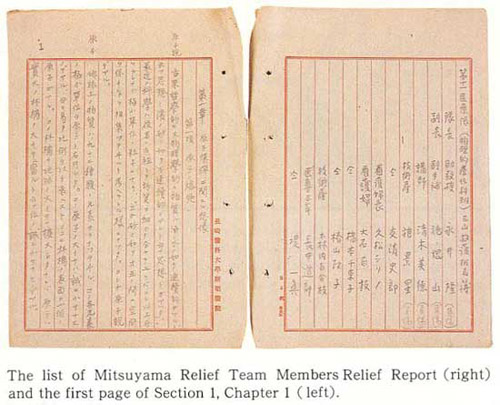Extracts from Doctor Takashi Nagai first report
In this first rescue report intended for the authorities of his University, Doctor Nagai sometimes refers to himself in the first person, sometimes under the name of the captain.

Map of Nagasaki and surrounding area
The 11th Medical Teams left the Urakami district on foot on the morning of August 12, 1945 to set up a relief station at Mitsuyama in a valley spared and known for its sources. He began to provide care from four in the afternoon of the same day. Mitsuyama’s team continued its relief activities for 58 days, until its disbandment on October 8, 1945.
© NASHIM (Nagasaki Association for Hibakushas Medical Care)
The explosion surprises Takashi Nagai at his desk in the Radium Room, arranging X-ray films into two piles. Five nurses, Yamashit, Hama, Inoue, Oyanagi, Yoshida had just gone to tend potato farmfield on the play ground. The image of nurses going unknowingly to death haunts their captain : “I kept watching their backs. The faces of five appeared in the front of my eyes, one-by-one, then disappeared.”. There will be 72 deaths among the staff of the university and that of the associated hospital.
Doctor Nagai is himself injured, suffering from numerous cuts on his right side due to shards of glass. The cut on his right temple is so deep it sections an artery. He conducts rescue operations with a bandage around his head before collapsing for a moment due to a loss of blood. « How could you have described the walking figures of our relief team ? A group of poor gypsies pushed out by the fire with no house, no boarding house, no dormitory… The clothes we had were only what we were wearing on our bodies. We barely escaped with life ».
It is this team that improvises the first aids: « You may imagine that the rescue operation was carried out courageously an rapidly, but this was not the truth. Our activities were slow because we ourselves were wounded to some degree just after coming out from being buried and had no vital power ».
The wounded continue to arrive from the city, sometimes crawling. Some collapse in front of the entrance. There are no more stretchers. The wounded must be evacuated by carrying them : « Below, the entire town was burning hard. The occasional west wind was pushing the fire, closer towards us. The hospital fire itself was becoming fierce. The captain glared at the sky for a while. Bring up the patients to the rear hill, 100 meters up the farm field, he ordered. The usual pass was destroyed and blocked. We had to climb rocks. One by one, we brought the patients up by hand ».
The next day it was possible to reach the pharmacy school. Urakami was totally changed ! There was only an open land of ashes. « Urakami district was a brown hill without houses, the morning sun skimming above it. The members of the small team looked in silence for their own houses in silence then looked down again. There was nothing left. Their family members must have been totally annihilated. »
Upon hearing the news of evacuation of the wounded by train, Dr. Nagai sent a team member to keep communication open. « He came back to report that the trains were full of wounded and could not transport all of them. The remaining wounded were lying on a grass field. I gave up. »
The second day was the worse for the team : « We were lying down all the day due to increased fatigue from radiation sickness. Furhermore, we did nothing for the critical patients moaning on the ground in front of us. Because no surgical supplies were left, we did not have the the will to take care of them, only ask “how are you ?” and let them drink water or eat pumpkin. Please forgive me ».

Extract from the Dr. Nagai handwritten report
List of Mitsuyama’s rescue team members (right) and copy of the front page of Doctor Nagai’s report found years after the Nagasaki bombing (left).
© NASHIM (Nagasaki Association for Hibakushas Medical Care)
In his report, the doctor repeatedly accuses himself of not having done enough. But as the preface to the Japanese edition says: « The 11th Medical Corps members were never negligent of their duties. They performed their medical duties under the harshest of survivors’ circumstances, an atomic wasteland. They worked when virtually all of them have been injured and should have been convalescing themselves. And they did their operations without the amenities of plentiful supplies, ambulances, and support staff».
Source : Atomic Bomb Rescue and Relief Report, Takashi Nagai, MD – Edited by Fidelius R.Kuo (2000)
Other articles on the subject « Military Applications »
Nuclear Weapons
Atomic and thermonuclear bombs There are two types of nuclear bombs: the atomic A bombs and the t[...]
The 1945 A-bombs
Little Boy and Fatman The United States had available three bombs in July 1945: two made of pluto[...]
The Franck Report
The Scientists who opposed dropping atomic bombs on Japan In June 1945, shortly before the atomic[...]
Nagasaki
A Japanese account of the Nagasaki bomb Atomic bomb, rescue and relief report, a poignant small b[...]
Atoms for Peace
1953: Eisenhower’s initiative for peaceful use of the atom After the Second World War, The [...]
Testing Nuclear Weapons
A practice that culminates in the 1950’s and 1960’s… The nuclear tests conducted by the sup[...]
Atomic Tests Fallout
An embarrassing legacy but alleviated with time Radioactive fallout differ significantly accordin[...]
Arsenals reduction
A modest step towards a reduction in nuclear arsenals During the Cold War, the United States and [...]